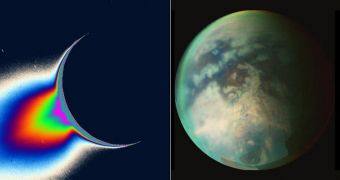It's not very often that the NASA Cassini spacecraft has the opportunity to perform double flybys. In fact, only a handful of such instances have occurred since July 1, 2004, when the orbiter achieved insertion in Saturn's orbit. The probe has been keeping an eye on the gas giant, its stripes, rings and moons ever since, and has collected a wealth of data on all these elements. Researchers at NASA are currently getting ready for a new double flyby, in which Cassini will zoom past the peculiar moon Titan, and the ice-covered Enceladus. Both space rocks are considered to be among the most interesting places in the solar system.
Titan captured the eyes and imagination of astronauts when Cassini radar data revealed the presence of what could be construed as lakes at the moon's north and south poles. During the 65+ flybys that the probe did around the space rock, scientists established a large number of Titan's properties, including the fact that the distribution of its lakes depends on season, that the structures themselves are probably filled with liquid hydrocarbons such as methane and ethane, and that some of its riverbeds feature beautiful ice crystals, produced by liquid flows.
Enceladus, on the other hand, is interesting because it may hold life. The surface of the moon is covered in a very thick layer of hard ice, but cracks exist in a region around its south pole. Through these features, called “tiger stripes,” the moon releases plumes of water and ice vapors, which apparently constantly fuel one of Saturn's rings with matter. Physicists and planetary scientists propose that existence of various plumes of warmer ice underneath the surface, but thus far their existence could not be accurately validated. The new flyby will hopefully provide additional details on both moons, say researchers at the NASA Jet Propulsion Laboratory (JPL) in Pasadena, California.
“The alignment of the moons means that Cassini can catch glimpses of these two contrasting worlds within less than 48 hours, with no maneuver in between. Cassini will make its closest approach to Enceladus late at night on May 17 Pacific time, which is in the early hours of May 18 UTC. The spacecraft will pass within about 435 kilometers (270 miles) of the moon's surface,” the experts add. The JPL manages Cassini for the NASA Science Mission Directorate, at the agency's Headquarters, in Washington DC.
“The second of Cassini's two flybys is an encounter with Titan. The closest approach will take place in the late evening May 19 Pacific time, which is in the early hours of May 20 UTC. The spacecraft will fly to within 1,400 kilometers (750 miles) of the surface. Cassini will primarily be doing radio science during this pass to detect the subtle variations in the gravitational tug on the spacecraft by Titan, which is 25 percent larger in volume than the planet Mercury,” the JPL team concludes.

 14 DAY TRIAL //
14 DAY TRIAL //